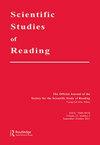加标点,还是不加标点?语法和韵律对成人逗号使用判断的影响
IF 2.4
2区 教育学
Q1 EDUCATION & EDUCATIONAL RESEARCH
引用次数: 0
摘要
摘要目的标点符号传统上被认为是写作中语法结构的表征,但也有一些作者认为它还可以反映语音的语调和停顿。在两个实验中,我们考察了语法和韵律对成人逗号位置判断的影响。方法大学生对不同句子结构中逗号的恰当性进行评分。其中包括主语和动词被逗号打断的句子。这些逗号不符合语法,但在韵律上是合适的,因为它们标记了说话中自然会出现轻微停顿的地方。结果在实验1中,192名学生认为非语法逗号出现在韵律停顿点比出现在非停顿点更合适。在实验2中,235名学生认为在韵律上恰当的逗号在语法上比在语法上不恰当的逗号更恰当。总体而言,具有较好书面语言技能的参与者更能区分语法和非语法逗号,但对韵律适当的逗号的接受程度在书面语言技能的各个水平上都有所不同。结论有文化的成年人在判断逗号使用是否恰当时,除了使用语法外,还会使用韵律。这些发现对标点符号理论具有启示意义,并可以为学生和教师对待标点符号的辩论提供信息。本文章由计算机程序翻译,如有差异,请以英文原文为准。
To Punctuate, or Not to Punctuate? Grammatical and Prosodic Influences on Adults’ Judgments of Comma Use
ABSTRACT Purpose Punctuation is traditionally seen to represent grammatical structures in writing, but some authors argue that it can also reflect the intonation and pauses of speech. In two experiments, we examined the influence of grammar and prosody on adults’ judgments of comma placement. Method University students rated the appropriateness of commas in various sentence structures. These included sentences in which the subject and verb were disrupted by a comma. These commas were ungrammatical, but prosodically appropriate, in that they marked where a slight pause could naturally occur in speech. Results In Experiment 1, 192 students rated ungrammatical commas as more appropriate if they occurred at prosodic pause points than at no-pause points. In Experiment 2, 235 students rated prosodically appropriate commas as more appropriate if they were also grammatical than if they were not. Overall, participants with better written language skills distinguished more between grammatical and ungrammatical commas, but acceptance of prosodically appropriate commas occurred across levels of written language skill. Conclusion Literate adults use prosody, as well as grammar, to judge the appropriateness of comma use. These findings have implications for theories of punctuation, and can inform debate on students’ and teachers’ treatment of punctuation.
求助全文
通过发布文献求助,成功后即可免费获取论文全文。
去求助
来源期刊

Scientific Studies of Reading
Multiple-
CiteScore
7.20
自引率
2.70%
发文量
26
期刊介绍:
This journal publishes original empirical investigations dealing with all aspects of reading and its related areas, and, occasionally, scholarly reviews of the literature, papers focused on theory development, and discussions of social policy issues. Papers range from very basic studies to those whose main thrust is toward educational practice. The journal also includes work on "all aspects of reading and its related areas," a phrase that is sufficiently general to encompass issues related to word recognition, comprehension, writing, intervention, and assessment involving very young children and/or adults.
 求助内容:
求助内容: 应助结果提醒方式:
应助结果提醒方式:


